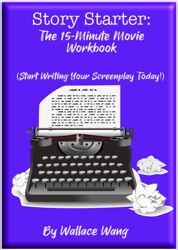When most people come up with an idea for a story, they usually focus on the characters, the plot, or the action that occurs in a single scene. All of this can be a great place to start, but a story is not about the characters, the plot, the action, or the setting. This is why putting A-list actors and directors on a project can never guarantee the project will be a success. It’s because a story is never about the details.
Instead, a story is really about the underlying dilemma that the story dramatizes. “Thelma and Louise” isn’t about two women who go wild on a road trip and run afoul of the law. “Thelma and Louise” is really about the dilemma between living as an oppressed woman in a male-dominated society vs. being free.
That’s it.
The story details then dramatize that dilemma but without a strong underlying dilemma for a story to dramatize, you won’t have a story at all. Just look at the parade of useless movies like “The 355”, “Borderlands”, or “Madame Web” that focus on action that ultimately means nothing because there’s nothing to dramatize.
In comparison, when Thelma robs a convenience store, the action is fairly mute. There’s no gunfire, no stunts, no car crashes, no explosions. It’s just a woman robbing a convenience store and running away with the money. Yet that scene is far more memorable because it shows Thelma’s emotional change from a timid housewife to a woman who wants to control her own life, even if she does it in an illegal manner.
Then watch the pointless action in a bad movie like “Borderlands” where even the best special effects and stunts mean nothing because it does nothing to reveal anything about the characters. If you watch this scene from “Borderlands”, you’ll see the hero calmly and expertly firing her guns at enemies. Then for some reason, she pops out of a crate and fires, not because it makes sense, but because it looks cool.
Why would the hero, who was standing outside of a crate, suddenly jump into a crate just so she could pop up and fire her guns? This type of nonsensical action is not only illogical, but doesn’t reveal anything about the hero or any of the other characters fighting alongside her.
The “Borderlands” scene has far more action than the scene in “Thelma and Louise” where Thelma robs a store, yet the scene where Thelma robs a store is far more meaningful because it shows her growth as a character where the fighting scene in “Borderlands” reveals nothing about the story or the characters.
More action does not equal a better story. Meaningful action, no matter how small, creates a better story.
Watch every scene in “Thelma and Louise” and it’s always about two women trying to find freedom in a male-dominated world. Watch every scene in “Borderlands” and you’ll have no idea what the story, plot, characters, or setting is about because there is no underlying dilemma that the story dramatizes.
Watch every great movie and you’ll be able to identify this underlying dilemma. “The Shawshank Redemption” is about hope vs. despair. “Harold and Maude” is about life vs. death. “Terminator 2” is about whether killing is justified vs. killing is wrong.
Strip away this underlying dilemma and you don’t have a story at all no matter how many A-list actors and special effects you throw at the story. This is something Hollywood fails to learn time and time again.
For your own story, identify what your story is about without relying on details like character, setting, or plot. When you can come up with an interesting dilemma like “Thelma and Louise” (oppression for women in a male-dominated world vs. freedom), then you’ll have a strong foundation to create a great story by dramatizing this dilemma.
Sign up to take a FREE course about how to write scenes in a screenplay.

